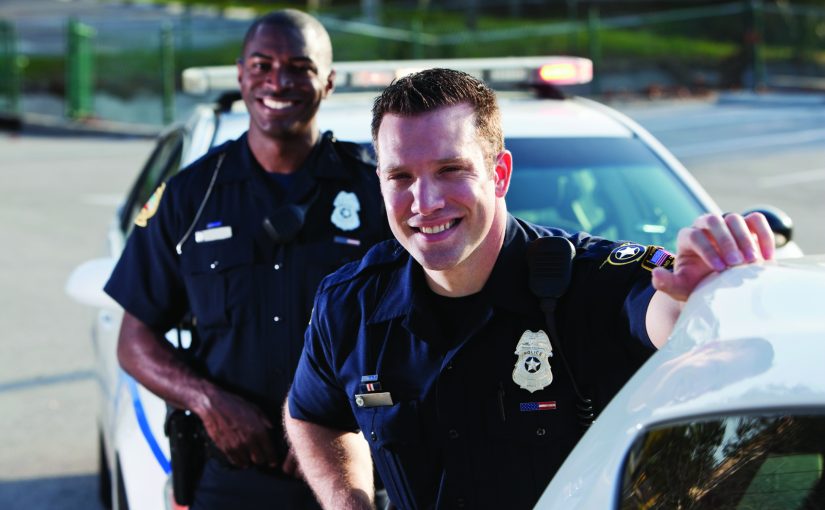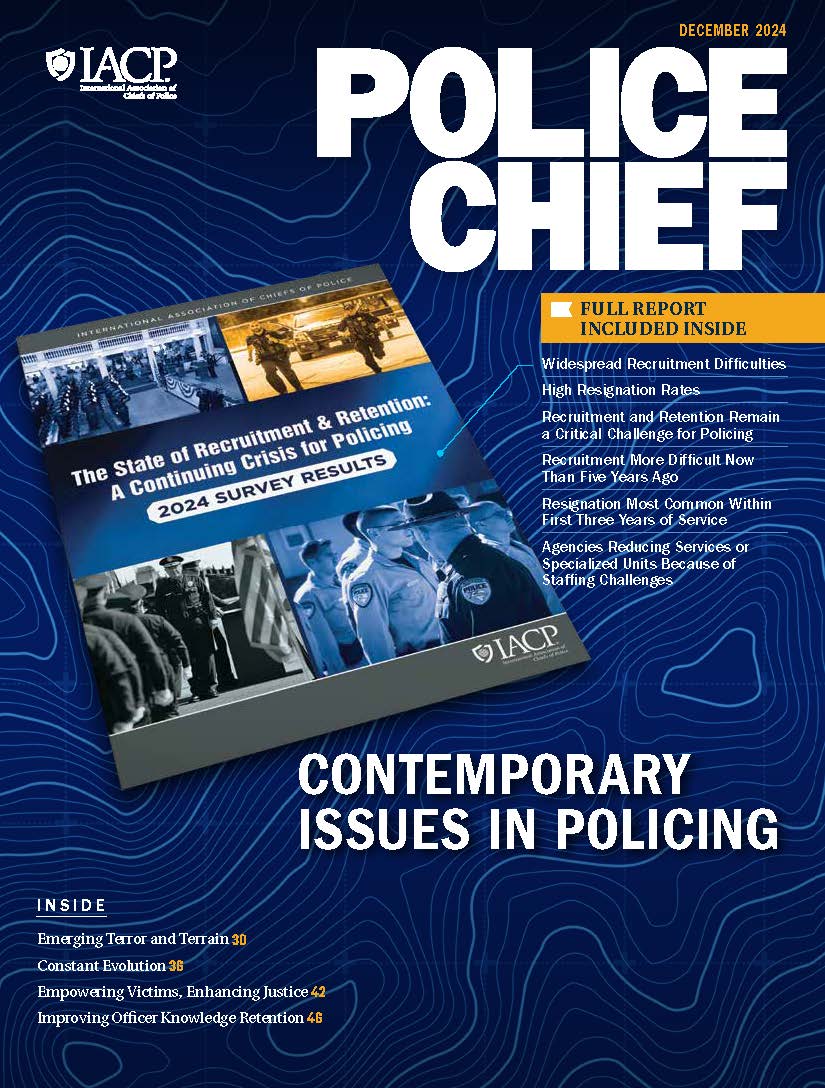Direct and vicarious trauma experienced in policing is distinct from most other professions because of the transdisciplinary responsibilities of the job. Police often arrive on the scene of traumatic incidents first and leave last. Police officers interact with fellow first responders as well as with individuals who are in their most vulnerable states. Along with their contacts with victims, witnesses, and perpetrators, officers later may have to cooperate with investigators, district attorneys, defense attorneys, community members, the media, and their own command staff. Still, civilians expect officers to always be courteous, knowledgeable, professional, and effective at solving problems.
Balancing the emotional impacts of trauma along with the routine grind of the job can create high levels of stress along with doubt, frustration, angst, exhaustion, and more. The result is a weakened state of wellness, where physical symptoms of psychological problems can develop in even the healthiest officer. Most troubling is that the lack of wellness, in far too many cases, has led to suicide.
Police wellness has received a great deal of attention recently from research, policy, and police leadership.1 Organizationally, resources are available to help decrease the stigma surrounding mental health, provide support to officers in distress, and increase awareness of the warning signs of psychological danger.2 However, a gap exists in the way knowledge is translated into practical tools that officers feel comfortable using. Groundbreaking research does nothing to effect change if it is not delivered in a sensible way to those who need it most. Translating the research into actionable practices and useful tools in the law enforcement community, particularly when it comes to wellness, requires a solution that can be an alternative for officers who are reluctant to seek therapy and a mechanism for all officers to acquire knowledge on their own terms.
The largest obstacle to police wellness is the officer. An organization can create a culture of wellness and can provide support for officers to remain healthy; however, the organization cannot make or keep officers well. Only individuals can complete the steps necessary to build their own wellness plan. Health begins with an understanding of what wellness is and extends into the creation of an individualized wellness plan that is then executed throughout one’s career. Wellness comes only through individual hard work and a personal commitment to health. To do this successfully requires the development of intentional grit.
Intentional Grit: A Precursor to Mental Resilience
Intentional grit is one’s passion and perseverance to pursue a goal to its achievement. The presence of intentional grit readies the individual to overcome challenges, steels one to attack unanticipated challenges head-on, and provides the motivation necessary to refuse to quit for as long as it takes to get the job done. Intentional grit is the defining difference between someone who learns just to gain knowledge and someone who learns in order to apply, execute, and evaluate knowledge in action.3 Grit is a level of determination and mental aptitude so powerful that, in situations where outcomes hinge on critical decision-making skills, the person with the highest level of grit perseveres.4 Intentional grit is a key building block to the achievement of mental resilience. With the commitment necessary to overcome obstacles, the individual develops the inner confidence that challenges, set-backs, and traumas are surmountable.
Mental Resilience
The decision to accept personal responsibility for building mental resilience through an attitude of intentional grit is much easier to make once there exists a clear value proposition associated with the outcome. A number of definitions of resilience exist, including the ability to absorb external stressors, a body’s capacity to anticipate and defend against risk and change, and a person’s level of adaptation to the environment to avoid potential losses.5 Each type of resilience is certainly helpful to the psychological flexibility of law enforcement officers. However, when tied into their unique job requirements, the mental resilience officers need to build and maintain wellness must take into consideration the very types of repetitive stressors that can cause far-reaching harm.
Mental resilience is a direct reflection of the current status of each human system (i.e., physical, cognitive, emotional, social, environmental, occupational, and spiritual) and is constrained by time.6 The amount of resilience a person has in the moment is dependent on the system’s ability to withstand disruption and recover within acceptable parameters of time, cost, and risk. Consider, for instance, the training of police officers who excel as patrol officers. Because of these officers’ excellence on the job, they are moved into a supervisory position. Their resilience is no longer being tested based solely on their abilities in patrol. They are now faced with a new paradigm: leadership. How quickly can they recover from the shift in performance expectations? What kind of an investment will training them to lead others require of themselves and the organization? What level of risk do they take on personally for accepting the responsibility of the consequences of their subordinates’ choices? Resilience, in this situation, is measured not only on a personal level but on an organizational level as well. However, if the individual in question lacks mental resilience, the impact to the team, shift, and department as a whole is expressed in negative terms.
Three Types of Prevention
Accepting personal responsibility for something that is not easily developed begins with answering a very simple, yet powerful question: What’s in it for me? The benefits of mental resilience are extensive, and, inside the wellness paradigm, are best expressed in terms of prevention. Law enforcement officers, more so now than in any other time, are being made aware of the psychological dangers of the profession.7 However, even with awareness of the likelihood of developing symptoms of mental distress, individuals still choose to enter the profession because the desire to effect positive change is greater than the desire to avoid the risks associated with the job.8 Training law enforcement officers in mental resilience, as a preventative measure, provides a healthy buffer that protects them against the long-term influences of stress and trauma.9
There are three types of prevention that greatly increase the power of mental resilience over negative consequences of stress and trauma.10 Primary prevention occurs when mental resilience is applied before a person is exposed to a traumatic experience. In the law enforcement profession, academy trainees or incoming rookies who receive mental resilience training are participating in a primary prevention method that seeks to prepare them for what is likely to happen. Secondary prevention occurs immediately following a traumatic experience. The goal of the secondary prevention tool is to assist officers with early identification of acute disorders. For example, when the symptoms of posttraumatic stress do not alleviate in the weeks following a critical incident, officers can recognize the potential of a serious issue and know whom to contact for help recovering. Tertiary prevention is focused on improving quality of life through the reduction of symptoms that have long become a way of life. For officers who have been on the job for a number of years and who have managed to live with disruptive symptoms, tertiary prevention training provides much-needed relief from years of silent suffering.
When explained through the preventative lens, taking on the responsibility of wellness becomes less of a burden and more of a ray of hope. Law enforcement officers are doers. They want to have some control over their lives, the outcomes of their efforts, and their wellness. As such, teaching them to apply knowledge, build aptitude, and practice what they learn provides them with power over their minds and bodies. The more tools officers have and the more dedicated they are to applying those tools, the likelier they are to withstand the negative implications of environmental stressors and traumatic experiences.
 The Characteristics of Mental Resilience
The Characteristics of Mental Resilience
The psychological needs of an elite law enforcement workforce are met by gathering knowledge and resources from multiple disciplines. From the practice of cognitive behavior therapy (CBT), mental characteristics, including empathy and socialization, combine with behavioral tools, such as journaling, homework activities, and socializing. Additionally, the officers benefit from psychological capital (PsyCap) characteristics of hope, self-efficacy, and optimism. PsyCap enables the individual to operate in a fully functional, best-self capacity in even the most critical of situations.11 One promising tool, which combines the principles and techniques of CBT and PsyCap is the HEROES Project, which provides a six-week online curriculum filled with a number of therapeutic activities delivered directly to officers without requiring them to visit a therapist’s office.12
Application of the HEROES Project
The HEROES Project was piloted by first responders who were recruited for their interest in wellness and willingness to the complete the curriculum on their own time. Video lectures, lasting between 30 and 60 minutes in length, were uploaded into an online classroom every Monday for six weeks. Homework was also assigned the same day, with the weekly due date of Sunday. Trainees completed the work privately, at a pace they found comfortable, and, as a number of them shared, repeated the video lecture a number of times during the week in order to fully apply the material. Three primary themes emerged over the course of the training with personal, cultural, and organizational implications.
Theme One: Self-Awareness. The first week of training introduced the need for an individual wellness check. Through the act of building a strategic wellness map, trainees had to evaluate themselves within each system: physical, emotional, spiritual, professional, mental, and financial. Within each system self-evaluation, they were prompted to pose the following question, “Am I operating at my fullest potential?” If the answer was no, they were tasked with setting a wellness goal that represented their potential. In the weeks that followed, they built strategic plans for achieving each wellness goal.
The theme that revealed itself at the very start of the training spoke to the heart of self-awareness. More than 70 percent of trainees said that this training was the first time since graduating from the academy that they paused to consider what they wanted life to look like. Pausing for self-reflection and physically denoting progress or a lack thereof provided a powerful visual representation of reality for them. As one trainee put it, “Five years ago, I graduated the academy and had big goals for myself. This map doesn’t look at all like I thought it would. How did I allow myself to get so apathetic?” His words were echoed by many of his colleagues. To the participants’ credit, however, they refused to hold onto the past and chose to lean into the discomfort of self-growth.
Theme Two: Culture Change. At this point in the training, the focus on resilience turns to past performance. Learning from decisions and behaviors can be difficult without the wisdom and advice of a respected peer. To help remove the blinders to personal weakness, trainees approached members of their departments with a two-part assignment. First, the trainees were tasked with explaining why they chose the person they did, and second, they had to ask that person for help. For example, one officer approached a sergeant from a different shift because, despite not knowing the sergeant personally, the officer perceived that the sergeant always looked squared away. His uniform was kept perfectly, and the sergeant carried himself with confidence and professionalism. The young officer told the sergeant that his professional carriage was responsible for the amount of respect he had for him. Before even asking for advice, the young officer established respectful rapport that resulted in a powerful conversation about how to improve the officer’s people skills amid large crowds (the developmental area the young officer sought help with).
A resilient culture is a direct reflection of the amount of respect the officers inside a department have and show for one another.13 The feedback that trainees shared after completing the assignment focused on two things: building internal relationships and knowing the value of learning from others. The daily practice of policing is really quite solitary. The purposeful engagement of respected peers into conversations that were intended to seek sage advice acted as a connection tool between trainees and the professionals they looked up to. The internal relationship building naturally resulted in mentorship relationships that continued long after the training ended. One trainee wrote, “Hearing what I was doing wrong wasn’t nearly as hard as I thought it would be because it was like talking to one of my heroes. If your hero tells you to change something, you know it’s because he wants you to be better.”
Theme Three: Professional Development. In the final lesson, students take part in an exercise that requires them to complete a wellness resolution. In the resolution statement, they acknowledge the personal responsibility that wellness requires, and they outline a plan of action for maintaining balanced health. In the resolution, they state a determination to continue building intentional grit in the face of adversity. To do so, they must continue gathering resources along the way that will help strengthen their odds of success. Finally, they share the resolution statements with their close friends and family.
Surprisingly, a vast majority of trainees commented on the need for integrating their wellness attributes into professional development plans at work. Rather than easily measurable metrics like the number of tickets written or arrests made, trainees wanted suggestions from the researcher on ways to translate the characteristics they built onto their annual performance evaluations. One trainee suggested creating a separate wellness category that measured mental resilience based on behavioral expressions of psychological skills like empathy, self-care, and autonomous leadership. The general consensus was one of support for the continued pursuit of and occupational reward for mental resilience along the professional lifecycle.
Implications for Police Wellness
Police suicides are occurring at an alarming rate; therefore, officer mental health challenges demand a proactive solution.14 Leaders in the law enforcement community who are looking for a starting point for building a wellness culture can begin by setting a high bar for wellness. First, acknowledge that wellness is an individual endeavor. Provide officers with a resource that meets them where they are and teaches them how to establish personal wellness. Inside the organization, establish policies and procedures that make wellness a priority in promotion, cross-training, and leadership decisions. Include metrics in performance evaluations that measure the psychological skills present in resilient officers. Recognize the need for self-care and reward it. Promote a culture of wisdom, granting those with incredible experience the opportunity to share sage advice. Even if they lack positional authority, experienced officers possess the powerful stories of resilience that younger generations of officers need to hear. Chiefs and executives who lead intentionally will build a culture of resilience. d
Notes:
1 Police Executive Research Forum, Building and Sustaining an Officer Wellness Program: Lessons from the San Diego Police Department (Washington, DC: Office of Community Oriented Policing Services, 2018).
2 International Association of Chiefs of Police “Mental Wellness of Police Officers.”
3 Angela L. Duckworth, Grit: The Power of Passion and Perseverance (New York, NY: Scribner, 2016).
4 Donald A. Maccuish, “Orientation: Key to the OODA Loop-the Culture Factor,” Journal of Defense Resource Management 3, no. 2 (2012): 67–72.
5 C.S. Holling, “Resilience and Stability of Ecological Systems,” Annual Review of Ecology and Systematics 4, no. 1 (November 1973): 1–23; David Woods, “Creating Foresight: Lessons for Enhancing Resilience from Columbia,” in Organization at the Limit: Lessons from the Columbia Disaster, eds. Bill Starbuck and Moshe Farjoun (Malden, MA: Blackwell Publishing, 2005), 289–308; Adam Rose and Shu-Yi Liao, “Modeling Regional Economic Resilience to Disasters: A Computable General Equilibrium Analysis of Water Service Disruptions,” Journal of Regional Science 45, no. 1 (February 2005): 75–112.
6 Yacov Y. Haimes, “On the Definition of Resilience in Systems,” Risk Analysis 29, no. 4 (April 2009): 498–501.
7 Kathryn C. Seigfried-Spellar, “Assessing the Psychological Well-Being and Coping Mechanisms of Law Enforcement Investigators vs. Digital Forensic Examiners of Child Pornography Investigations,” Journal of Police and Criminal Psychology 33, no. 3 (September 2018): 215–226.
8 Laura Werber Castaneda and Greg Ridgeway, Today’s Police and Sheriff Recruits: Insights from the Newest Members of America’s Law Enforcement Community (Santa Monica, CA: Rand Corporation, 2010).
9 Katy Kamkar, “High Cost of Anxiety (Guest Commentary),” Canadian HR Reporter, December 15, 2008.
10 Sadhbh Joyce et al., “Workplace Interventions for Common Mental Disorders: A Systematic Meta-Review,” Psychological Medicine 46, no. 4 (March 2016): 683–697.
11 Fred Luthans, Carolyn M. Youssef, and Bruce J. Avolio, Psychological Capital: Developing the Human Competitive Edge (New York: Oxford University Press, 2006).
12 Renee Kosor, Daniel Blumberg, and Konstantinos Papazoglou, “The HEROES Project: Building Mental Resilience in First Responders.” in Mental Health Intervention and Treatment of First Responders and Emergency Workers (Pennsylvania: IGI Global, 2019).
13 Luthans, Youssef, and Avolio, Psychological Capital.
14 Christal Hayes, “‘Silence Can Be Deadly’: 46 Officers Were Fatally Shot Last Year. More than Triple That—140—Committed Suicide,” USA Today, April 11, 2018.
Please cite as
Renee D. Kosor, Daniel Blumberg, and Konstantinos Papazoglou, “Intentional Grit: Training Mental Resilience in Law Enforcement Officers,” Police Chief online, May 8, 2019.



